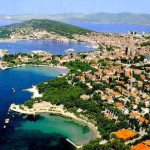Places to Visit in Croatia
Dubrovnik
Dubrovnik is the city of a unique political and cultural history (the Dubrovnik Republic, the Statute from 1272), of world-famous cultural heritage and beauty (inscribed on the List of
World Heritage Sites by UNESCO) – is one of the most attractive and famous cities of the Mediterranean.
Split
Split, is the largest and most important city in Dalmatia. It is the second largest Croatian city and the administrative centre of the Split-Dalmatia County.
It is situated on the eastern part of the Gulf of Kastela and the Split Channel. The 178 m Marjan Hill is on the western part of the peninsula and the Kozjak and Mosor ridges separate it from the hinterland.
The city enjoys a Mediterranean climate with hot and dry summers and warm, wet winters. The summer temperatures average at around 36°C, making it one of Europe’s sunniest places.
Opatija
Opatija, is located on the Adriatic Sea coast. it is called the Nice of the Adriatic.
The town is located on the Gulf of Kvarner at the foot of the U?ka Mountain. Winters are mild with temperatures of 5°C in January that rise to around 23°C in July making the summer the ideal time to visit. The coastal strip is lush and green and rich in rocky limestone deposits.
The city is Croatia’s most fashionable seaside holiday destinations and is well connected to both Trieste and Rijeka.
Historically, the town has been a holiday destination for some of Europe’s most prominent royals including Princess Luise von Sachsen Coburg, the Romanian King Charles I and the Swedish-Norwegian King Oscar.
Zagreb
The city of Zagreb, capital of the Republic of Croatia, is located in the north of the country on the Sava River. It is the country’s largest city, with just over 1,000,000 inhabitants in the metropolitan area.
Zagreb climate, the summers is hot and dry and the winters cold and with frequent snowfall. Autumn is a season of rain and fog and spring is the best season for a visit.
The history of Zagreb dates from 1094 when King Ladislaus founded a Cathedral and the settlement Kaptol developed to the north along with the fortifications of Gradec.
Cradec today is known as Gornji Grad and forms the city’s Upper Town, one of the best preserved city centres in Croatia with the the Gothic church of St. Mark’s
Zagreb is now a major international trade and business centre.
Hvar
Hvar is an important tourist resort with a centuries-old tradition in tourism.
Main attractions are pleasant climate, a lot of sunshine, natural beauty, various accommodation facilities, sports and recreational opportunities, etc. Hvar is great place to visit in the summer and winter months, and its very special climate favoured the development of health tourism.
Rabac
Rabac, is a village port on the south-eastern coast of the Istria. The island of Cres lies across from the city in the Kvarner Bay and Rabac leads to the Velika Vrata.
Rabac enjoys a sea-influenced mild Mediterranean climate. Winters are cold, the summer with temperatures of 19°C to 25°C makes it a popular time for tourists.
With its population of around 1,400, Rabac continues its tradition as a fishing village but it has boosted its tourist facilities as well.
Korcula
Korcula is the birthplace of the adventurer and traveller Marco Polo.
The town of Korcula, the historical centre of the island, has a very nice location in the Peljesac Channel.
It is also known for its outstanding cultural and historical heritage and a long tradition in seafaring, shipbuilding and stone-masonry.Tourism has a years-long tradition on the island.


